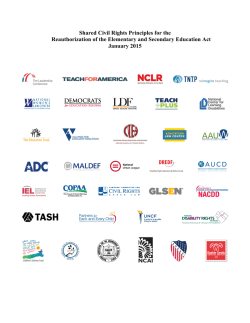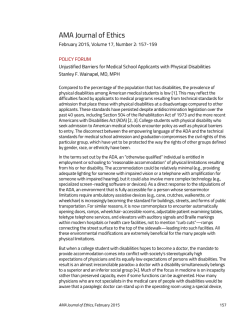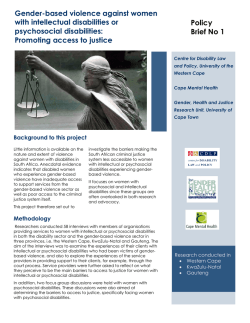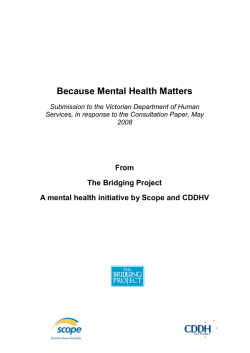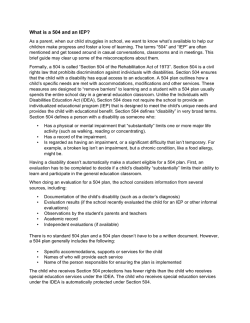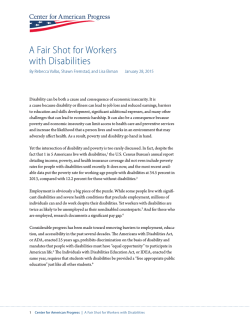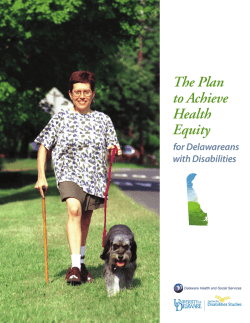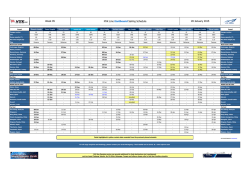
CCD Ed TF letter on Alexander bill
February 2, 2015 The Honorable Lamar Alexander Chair, Senate Health, Education, Labor and Pensions Committee 455 Dirksen Senate Office Building Washington, DC 20510 Dear Chairman Alexander: We write on behalf of the Education Task Force of the Consortium for Citizens with Disabilities (CCD) and thank you for the opportunity to provide feedback on the Every Child Ready for College or Career Act of 2015 (ECRCCA), amending the Elementary and Secondary Education Act (ESEA). Under the current version of ESEA, students with disabilities, who make up 13 percent of public school enrollment, have been given the opportunity to make progress in many areas. Since parents, teachers, and school leaders have had access to knowledge about how students with disabilities fare academically compared to their grade-level peers, students with disabilities have experienced improved access to the general education curriculum, reduced dropout rates, increased high school graduation rates in many states, and increased inclusion in general education classrooms throughout the country. However, despite some progress for students with disabilities, significant achievement gaps persist. A strong ESEA is necessary for students with disabilities to climb the ladder of success to career and college readiness. Only 10 percent of jobs in 2018 are expected to be open to high-school dropouts.1 CCD urges Congress to develop legislation that continues to provide meaningful access to rigorous standards for all students and fully includes students with disabilities in our education system. We are pleased that ECRCCA maintains some key provisions that consider the interests of students with disabilities. Specifically, the bill maintains: 1) disaggregation of data by student categories in current law (Sec. 1111(b)(2), Sec. 1111(d)(1), and Sec. 1111(d)(4)); 2) the 95% student participate rate in annual assessments (Sec. 1111(b)(3)); 3) the “parent right to know” provision, requiring that parents be informed that they may request information regarding qualifications of the student’s classroom teacher (Sec. 1112(d)); and 4) provisions on charter schools (Title V, Part A) mirroring the version supported by CCD in the last Congress. 1 A. Carnevale, N. Smith, J. Strohl, Help Wanted: Projections of Jobs and Education Requirements Through 2018 at Exec. Summ. 2 (Georgetown Univ. Ctr. on Educ. & the Workforce 2010). 1825 K Street, NW, Suite 1200 • Washington, DC 20006 • PH 202/783-2229 • FAX 202/534-3731 • [email protected] • www.c-c-d.org However, we are particularly concerned with several provisions in this draft and offer recommendations on how to better serve students with disabilities in a reauthorized ESEA: 1) Maintain annual assessments of all students in grades 3-8 and once in high school in reading and math; 2) Include all students with disabilities in state and district-level assessments; 3) Limit the Alternate Assessment based on Alternate Achievement Standards to 1% of students assessed; 4) Ensure that parents are involved in the decision that their child will take an alternate assessment and are informed about any effects that taking the alternate assessment may have on their child’s academic preparation to earn a regular diploma; 5) Use the term “provide access to and ensure progress in the general education curriculum for the grade in which the student is enrolled” instead of “promote access to the general education curriculum;” 6) Remove the option for LEAs to create and use their own assessments; 7) Ensure that any assessments are peer-reviewed and held to the professional assessment standards of being reliable, valid, and rigorous for the purposes of measuring students achievement with accommodations for students with disabilities; 8) Require SEAs and LEAs to report results for all subgroups with the only exception being if an “n” size in a cell falls below 10; 9) Ensure that students in every state who take the Alternate Assessment based on Alternate Achievement Standards are not precluded from attempting to complete the requirements for a regular diploma; 10) Require states to set high school graduation rate goals and annual targets for all students and student categories and require support to be provided if one or more categories do not meet annual targets; 11) Require SEAs and LEAs to intervene when schools or districts identify achievement gaps between students with disabilities and the general population of students; 12) Ensure that students with disabilities must be kept on track to graduate high school and have the access to the general curriculum; 13) Provide support to states and school districts to ensure that teachers have the skills and knowledge necessary to instruct diverse learners; 14) Prohibit the use of restraint and seclusion in non-emergencies that do not threaten physical safety; 15) Create grant programs that provide SEAs and LEAs with support to implement schoolwide positive behavioral interventions and supports; 16) Maintain funding for competitive grant programs support and address the social/emotional, physical and mental health needs of students; 17) Ensure that all assessments and curricula are designed and implemented using Universal Design for Learning and that all assessments are fully accessible; 18) Prohibit the transfer of funds between Titles II and IV; and 19) Prohibit the elimination of maintenance of effort provisions. 2 Our rationale for these recommendations is as follows. ASSESSMENT SYSTEM Annual Assessments: CCD believes it is imperative to continue the assessment requirements in current law, e.g., annual assessments of all students in grades 3-8 and once in high school in reading and math. Results from such assessments are critical for measuring achievement gaps among categories of students, student growth, and school, district, and state effectiveness. Inclusion of all students: Students with disabilities must be included in all state and district-level assessments. The vast majority of students will participate in the general assessment with accommodations as needed. States must provide either an Alternate Assessment based on Grade-Level Achievement Standards or an Alternate Assessment based on Alternate Achievement Standards for those students with the most significant cognitive disabilities. Neither a state nor local educational agency should be allowed to develop any other type of alternate assessment for students with disabilities, including, but not limited to, an alternate assessment on modified achievement standards. Alternate Assessments: The Alternate Assessment based on Alternate Achievement Standards (AA-AAS) for students with the most significant cognitive disabilities must include a limitation on the number of IDEA-eligible students who can be assigned to this assessment in order to avoid misuse. The number of students who can participate in state assessment systems via an AA-AAS should be no more than one percent of all students assessed. Incidence data reflects that less than one percent of all students have the most significant cognitive disabilities (which correspond to roughly 10% of students with disabilities). Without this limitation, we fear that schools may inappropriately assign students to the alternate assessment. Data show assignment to an AA-AAS may lead to reduced access to the general curriculum and limit a student’s access to earn a regular diploma. Many children with intellectual, cognitive, and other disabilities can make grade level achievement with regular assessments, particularly with appropriate accommodations, universal design for learning, and full accessibility. In addition, parents should be involved in the IEP team decision that their child will be taking an alternate assessment and should be informed of any effect that the alternate assessment may have on their child’s academic preparation to earn a regular diploma. Also, ECRCCA (Sec. 1111) uses the term “…promote access to the general curriculum” for students with the most significant cognitive disabilities. CCD urges you to change the term to “provide access to and ensure progress in the general education curriculum for the grade in which the student is enrolled” to ensure complete and consistent alignment with the Individuals with Disabilities Education Act (IDEA) and the Individualized Education Program (IEP) requirements. Locally-designed Assessments: CCD is strongly opposed to allowing Local Educational Agencies to develop and administer their own assessments in lieu of the state-designed 3 academic assessment system. Such an allowance raises many questions related to validity, reliability and equality for students who historically underperform, including students with disabilities. This option would also result in little if any comparability of assessment results across districts within states. Federal review and approval of assessments: ECRCCA eliminates the authority of the Secretary related to the peer review and approval of state assessment systems. CCD urges you to require that the Secretary play an important role in assuring the validity, reliability and equality of access to the development of both the general assessment and the Alternate Assessment based on Alternate Achievement Standards developed by each state. Both data and experience show that states do not always use scientific rigor or best practices in assuring that alternate assessments in particular are fully aligned to grade level academic content standards; that all assessments are appropriately accessible to allow students to demonstrate their full range of knowledge and skills; and that accommodations are properly provided with regard to assessing students with disabilities. In fact, there are numerous examples of problems related to these issues since assessment requirements were added to IDEA in 1997. States should be held accountable for the development and use of such assessments. ACCOUNTABILITY SYSTEMS Exceptions to disaggregation of data: The current draft continues to allow an exception to the disaggregation of student data where “the number of students in a category is insufficient to yield statistically reliable information.” This provision has historically been misused by many States which have set a wide variety of “n” sizes (e.g., California’s “n” size of 100) as determinants of statistical reliability to avoid reporting school and school district assessment outcomes for students with disabilities. Thus, language regarding disaggregation should be amended to ensure that a substantial percentage of schools and districts within a State are held accountable for all students. The provision should be changed to allow an exception only where “the number of students in a category falls below ten.” The National Center for Education Statistics (NCES) recommends that schools and districts use a minimum of 10 students for the reporting subgroup size limitation.2 Whenever possible, results should report the actual numbers of students in the category except where such data would reveal personally identifiable information about an individual student. A subgroup size of 10 students would accomplish this. (See Appendix A for information on the percentage of students with disabilities enrolled in schools held accountable.) Addressing Achievement Gaps: CCD urges that SEAs and LEAs be required to intervene when schools or districts determine, using the disaggregated data, that there is, or continues to be, a gap between the achievement of students with disabilities and the general populations of students. The transparency of data must be used to trigger additional resources and interventions when achievement gaps occur. 2 National Center for Education Statistics (2010). Statistical Methods for Protecting Personally Identifiable Information in Aggregate Reporting. SLDS Technical Brief Guidance for Statewide Longitudinal Data Systems (SLDS), December 2010, Brief 3. 4 GRADUATION Targets and Disaggregation: All students – including those with disabilities – must leave high school prepared to succeed in postsecondary education and/or in the workplace. All students with disabilities should be on the path to receive a regular diploma and the vast majority of them should be expected to graduate. No students with disabilities should be denied the opportunity to pursue this achievement. Earnings for an adult with a high school diploma are $9,000 greater on average that a dropout; earnings for a person with a bachelor’s or associates’ degree, even higher.3 ECRCCA does not include any requirement that states and districts set graduation goals and/or targets for all students and every category of students, nor does it place any emphasis on graduation in state accountability planning and reporting on use of Title I funds. ESEA must require states to set high school graduation rate goals and annual targets for all students and student categories and require support to be provided if one or more categories do not meet annual targets. If these targets are not set, it is feared that schools will push out low performing students to bolster their school’s perceived academic performance. EDUCATORS Skills and Knowledge: Requirements in Title II should ensure that all general and special education teachers have the skills and knowledge necessary for teaching grade-level content using universal design for learning to instruct diverse learners. States must be required to ensure that qualified teachers are available in every school. ECRCCA does not provide for the equitable distribution of teachers in high-need schools, which can lead to a disparate impact on low-income students with disabilities. ESEA should provide support to states and school districts to ensure that teachers are profession-ready before becoming the teacher of record, including that they hold a bachelor’s degree and demonstrate in-depth content knowledge in their area of licensure; fulfill the requirements of a state-approved preparation program that includes clinical experiences that use models of accomplished practice and instructors with K-12 experience; complete a comprehensive residency program in partnership between a teacher preparation program and a local school district that engages teacher residents in a series of school-based experiences and teaching enrichment opportunities under the guidance of accomplished educators; and demonstrate proficiency through a valid and reliable classroom-based performance assessment. STUDENT HEALTH AND SAFETY Use of restraint and seclusion: ESEA should prohibit the use of restraint and seclusion in non-emergencies that do not threaten physical safety, prohibit the use of aversive behavioral interventions that compromise health and safety, and protect all students from 3 A. Carnevale, S. Rose, and B. Cheah, The College Payoff: Education, Occupations, and Lifetime Earnings at 3 (Georgetown University Center on Education and the Workforce 2011). 5 physical and mental abuse. An ESEA reauthorization must include supports for SEAs and LEAs to require the use of evidence-based, positive and preventative strategies to promote a positive school culture and climate and keep all students, including students with the most complex and intensive behavioral needs, and school personnel safe. This is also important since research has shown that when schools have a positive school climate and meet the social, emotional and behavioral needs of students, academic achievement improves. Social/emotional and mental health: Addressing students' social/emotional, physical and mental health needs is critical to ensuring they are prepared to learn. Unfortunately, ECRCCA consolidates a number of competitive grant programs providing targeted funding to school districts for services and supports that address the whole child, such as the Elementary and Secondary School Counseling Program, 21st Century Community Learning Centers, and the Carol White Physical Education. The block grant approach will require school districts to make difficult choices among an array of critical services, resulting in fewer students receiving the supports they need to succeed. UNIVERSAL DESIGN FOR LEARNING AND FULL ACCESSIBILITY All national, state and district-wide assessments must be developed using the principles of Universal Design for Learning (UDL) and must be fully accessible. Furthermore, UDL and full accessibility must be incorporated into all curriculum objectives, materials, teaching methods, classroom instruction, and classroom assessment. While it is good that this draft calls for the Alternate Assessment on Alternate Achievement Standards for students with the most significant cognitive disabilities to be developed using “universal design,” UDL should not be limited to the alternate assessment. All assessments should incorporate Universal Design for Learning and be fully accessible. Please note also that the bill uses the term "universal design" rather than “Universal Design for Learning,” the latter being the appropriate term in the educational setting. FUNDING Transferability of Funds: Title VI, Sec. 6101 allows states to transfer funds from the title for which specific funds are allotted to be used in another area. This provision specifically allows for the transfer of funds between Titles II and IV, both of which are critical to the successful implementation of the law. Title IV programs, already limited through the block grant approach of the bill, must receive adequate funding to ensure appropriate services are available to students. Title II ensures well-prepared teachers and principals and assistance in providing ongoing training to all school personnel. This provision should be removed, as the transfer of funds from either title will seriously diminish the impact of these programs on the success of students. Maintenance of effort: CCD strongly opposes the elimination of the “maintenance of effort” provision. This provision, a cornerstone of ESEA since passage in 1965, requires districts that receive Title I funding to maintain approximately the same spending levels on education from year to year. Title I funding is designed to help low income and disadvantaged students, including students with disabilities. Without the maintenance of 6 effort provision, states and local school districts will be free to slash education budgets while remaining eligible to receive annual Title I federal funds, thus weakening the power of federal investments to raise achievement for disadvantaged children. We know that you share our goals of ensuring that students with disabilities have excellent teachers in settings where they are most likely to succeed and that they have the opportunities to achieve to high standards and be prepared for post-secondary education and careers. Thank you for considering our thoughts on this draft of ECRCCA and thank you for your efforts to update and improve ESEA. We would be happy to provide any further information or answer any questions. We look forward to working with you on this important piece of legislation Sincerely, ACCSES American Academy of Pediatrics American Association on Health and Disability American Association of People with Disabilities American Foundation for the Blind American Network of Community Options and Resources Association of Assistive Technology Act Programs Association of University Centers on Disabilities Autism National Committee Autistic Self Advocacy Network Conference of Educational Administrators of Schools and Programs for the Deaf Council of Parent Attorneys and Advocates, Inc. Council for Learning Disabilities Disability Rights Education & Defense Fund Easter Seals Higher Education Consortium for Special Education Mental Health America National Alliance on Mental Illness National Association of Councils on Developmental Disabilities National Association of School Psychologists National Association of State Head Injury Administrators National Center for Learning Disabilities National Council on Independent Living National Disability Rights Network National Down Syndrome Congress National Down Syndrome Society National Respite Coalition Perkins TASH The Advocacy Institute The Arc 7 The Autism Society The Bazelon Center for Mental Health Law United Cerebral Palsy cc: Members of the Senate Health, Education, Labor and Pensions Committee The Consortium for Citizens with Disabilities is a coalition of national consumer, advocacy, provider and professional organizations headquartered in Washington, D.C. Since 1973, the CCD has advocated on behalf of people of all ages with physical and mental disabilities and their families. CCD has worked to achieve federal legislation and regulations that assure that the 54 million children and adults with disabilities are fully integrated into the mainstream of society. For additional information, please contact: Eileen Dombrowski, Easter Seals Lindsay E. Jones, National Center for Learning Disabilities Laura Kaloi, Council of Parent Attorneys and Advocates Kim Musheno, Association of University Centers on Disability Cindy Smith, National Disability Rights Network 8 202.347.3066 202.628.2662 202.349.2310 301.588.8252 202-408-9514 [email protected] [email protected] [email protected] [email protected] [email protected] APPENDIX A SOURCE: The Inclusion of Students with Disabilities in School Accountability Systems - An Update, October 2013, US Dept. of Education 9
© Copyright 2026
